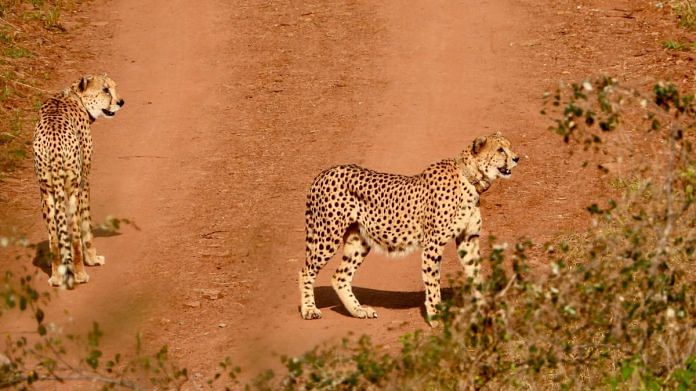Bhopal: A pair of two male cheetahs — Agni and Vayu — were released by the forest department in the Parond forest area of the Kuno National Park Sunday. According to the department’s press note, “This area is part of Ahera tourism zone. Due to the presence of cheetahs in the tourism zone, tourists can now see cheetahs during safari visit.”
This comes after the 11-member Cheetah Steering Committee, amid concerns of a prey base, had given an in-principle approval to release cheetahs into the wild.
The committee, headed by Dr Rajesh Gopal, during their meeting on 27 October had stated that cheetahs will not be released from the larger enclosure into the wild unless the prey population is at an appropriate level of 35 animals per sq km and ideally to 50 per sq km. The committee had also ordered a survey to be conducted by the Wildlife Institute of India (WII).
Speaking to ThePrint, Uttam Sharma, Chief Conservator of Forest, explained that the prey base still remains a concern and the WII is conducting its survey in the 350 sq km area of the park.
“But we have identified some portions of the park where the prey density was found to be adequate and a decision to release these cheetahs into those pockets were taken with the steering committee giving an in-principle approval,” he said.
According to officials from Forest Department Madhya Pradesh, the in-principle approval to release cheetahs into the wild was also taken considering that the wild cats, following their arrival in India, had spent barely any time out in the open.
“Male Cheetahs, much like tigers, mark their territory, and if Agni and Vayu mark their territory in the safari zone, which comprises 20 percent of the park, there is a possibility of the tourism being able to spot them,” said CCF Uttam Sharma. “Safari inside the tourism zone of the Kuno National Park has been allowed and even on Sunday there were tourists inside the park when the two cheetahs were released into the wild.”
The release of the first pair of two male coincides with the Kuno Forest Festival, being held between 17 and 21 December to promote tourism. Various activities and workshops are being organised during the festival, such as hot air ballooning, paramotoring and jungle safari.
Also read: Cheetahs won’t be sent into wild unless prey base is sufficient; action plan inadequate, says panel
More to be released
Project Cheetah was launched on 17 September, 2022, with the introduction of eight cheetahs brought from Namibia at Kuno. This was followed by the release of 12 more cheetahs brought in from South Africa in February. After spending the required time in the quarantine bomas and subsequently into larger enclosures, these cheetahs were released into the wild.
The Cheetah Project reported its first death on 27 March, which was soon followed by the death of cheetah Uday on 14 April and Daksha, a female cheetah, on 9 May.
The project landed in further trouble after two cheetahs named Tejas and Suraj died of maggot infection on 11 and 14 July, respectively, and another female cheetah, Dharti, died on 2 August. This resulted in the 14 free-ranging cheetahs being recaptured and put into quarantine by 13 August.
It was finally in September 2023, the one-year anniversary of the Cheetah project, that it was decided that the cheetahs will be released again into the wild during the winters. However, the plan was shelved once again after the steering committee on 27 October pointed out low prey base as a concern.
Senior officials of the forest department in MP explained that considering that these cheetahs had spent most of their time inside larger bomas, or the quarantine bomas, it was high time that they were released into the wild. Subsequently, pockets with a substantial prey base of chitals were identified, which included the Ahera tourism zone. Several other such pockets that have been identified for the release of other cheetahs include Khajure and Jakoda ranges lying both in the east and western part of Kuno National Park.
According to forest officials, another six to eight cheetahs would be released from the larger bomas into the Kuno National Park over the next 20 days. Along with this, forest officials have also received an in-principle approval from the Central Zoo Authority (CZA) for construction of a cheetah safari on the lines of the Devaliya safari in Gir National Park.
(Edited by Zinnia Ray Chaudhuri)
Also read: Illegal wildlife trade—the most profitable crime in the world according to Interpol






